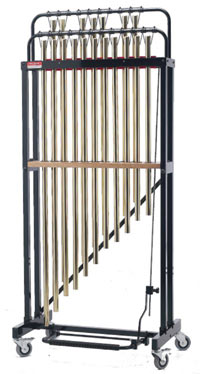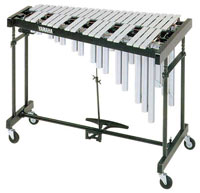Perfect Percussion (Part 2) - Building the complete section
11-Jun-2008Dave Danford continues his series of how to build a percussion section of instruments that will do just the right job.
Tuned Percussion:
Tuned Percussion instruments continue to be used more and more in brass band concert and contest works. Glockenspiel, tubular bells and xylophone have been a permanent fixture in the section for decades, partly due to the popularity of orchestral transcriptions. The vibraphone is now considered to be a requirement in higher section bands.
 a) Glockenspiel
a) Glockenspiel
The glockenspiel is used more than any other tuned percussion instrument in brass band repertoire. The portability helps but it’s the cutting sound, in stark contrast to brass instruments, that makes the glockenspiel such an attractive textural colour to use.
Premier have two orchestral glockenspiels in their catalogue. The 0570 Concert Series model has notes held in place by note-pegs whereas the 6801 Orchestral Series model has cord suspended notes giving the sound a much longer decay time.
Another difference is the width of the notes, which are much wider on the 6801. Accuracy can be difficult on the narrow notes of the 0570 and it’s particularly easy to hit the note-pegs which never sounds good! There’s not a huge amount separating the instruments price-wise so the 6801 Orchestral Series model is definitely the one to go for.
Yamaha have three different glockenspiels in their range, although the top of the range YG 2500 pedal model is slightly impractical for touring brass band use. There’s not much to choose between the two other models (YG 250D / YG 1210), both of which are great sounding and easily transportable.
Recommended models:
Premier 6801 Suspended Notes Glockenspiel
Yamaha YG 250D Glockenspiel (5mm thick bars)
Yamaha YG 1210 Glockenspiel (7.8mm thick bars)
Apart from larger pedal models, Glockenspiels generally need a stand to be purchased separately. Quiklok make two ideal models, the standard T-10 and the heavy-duty QLX-21, both of which hold the instrument securely and fold up for easy transport.
 b) Tubular Bells
b) Tubular Bells
These are relatively expensive instruments but there really is no substitute for a full set of tubular bells. Quality sets are available from Adams, Premier and Yamaha and sound-wise it’s worth investing in the largest note width available.
If you expect to be transporting the tubular bells to concerts then the Adams models are by far the most suitable as they pack down into smaller sections.
Recommended models:
Adams BK2001 Symphonic Chimes (1.25” tubes)
Adams BK3003 Symphonic Chimes (1.5” tubes)
Adams BKL5000 Philharmonic Chimes (1.5” tubes)
Premier 0875 (1.5” chrome plated tubes)
Premier 0875B (1.5” brass lacquer tubes)
Yamaha CH 500 (1.5” tubes)
c) Xylophone
Orchestral transcriptions are partly responsible for the xylophone’s regular position in the brass band percussion section, but it is as a solo instrument that it has really cemented its place. A xylophone solo is the standard percussion feature and there’s an exhaustive back catalogue of these available.
Xylophones range in size between three and four octaves but it is the 3.5 octave version that seems to have been accepted as the standard.
The note-bars can be made from padauk, light rosewood or Honduras rosewood, with the latter producing the best sound by far. Although there are a number of companies making xylophones, the Adams and Yamaha models are by far the most suitable for brass band use. The frame used for the Adams instruments is ideal for packing down for transportation between rehearsals and concerts.
 Recommended models:
Recommended models:
Adams 3.5 octave (light rosewood bars)
Adams 3.5 octave (Honduras rosewood bars)
Adams 4.0 octave (light rosewood bars)
Adams 4.0 octave (Honduras rosewood bars)
Yamaha YX-135 (padauk bars - not height adjustable)
Yamaha YX-350A (Honduras rosewood bars)
d) Vibraphone
The vibraphone is now commonplace in the brass band percussion section and is used regularly for both contest and concert works. Unfortunately they’re not cheap (unless you find a bargain in the second-hand market) but it’s worth investing in one if you have a few competent players in your percussion section.
The width of the note-bars is an important consideration. Entry-level instruments have bars of 30-35mm which remain the same width throughout the range.
Higher end models have wider graduated bars which can be up to 40mm at the top end gradually increasing to 60mm as you get further down the instrument. Wider note-bars are more resonant and help with note accuracy, especially in fast sections and four-mallet work.
 There are a number of models suitable for brass band use starting with the lightweight Yamaha YV 520. This model is ideal if space is at a premium and you’re planning on regularly taking the instrument out to concerts.
There are a number of models suitable for brass band use starting with the lightweight Yamaha YV 520. This model is ideal if space is at a premium and you’re planning on regularly taking the instrument out to concerts.
However, it’s not the easiest to use playing-wise as the notes are only 32mm wide making four-mallet chords particularly awkward. Yamaha’s next model up is the YV 1600A which is a good all-round vibe with 39mm wide note bars.
Premier still have their 0751 Orchestral Series Vibraphone available, which has been a popular workhorse for decades. This quality design has stood the test of time mainly thanks to regular improvements which recently included a revamped motor. The wide note bars also make it an easy instrument to play.
Adams have long been established as a strong choice for xylophones but it is their relatively new range of vibraphones that’s gaining support from many players and ensembles in the UK. One of the strong selling points is the frame which is very strong and sturdy when assembled but can be packed down into manageable pieces for transport. However the best feature of the Adams vibraphones is the motor, which is completely encased in one of the frame’s end-pieces.
Vibraphone motors are notorious for going wrong (in part due to their reliance on rubber bands!) but having all of the electronic parts so well protected can only be a good thing.
Recommended models:
Adams Soloist Vibraphone (38mm – 50mm graduated bars)
Adams Concert Vibraphone (38mm – 57mm graduated bars)
Adams Artist Vibraphone (38mm – 57mm graduated bars)
Premier 0751 Orchestral Series Vibraphone (graduated full-width bars)
Yamaha YV 520 Vibraphone (lightweight – 32mm bars)
Yamaha YV 1600A Vibraphone (39mm bars)
e) Marimba
The marimba is something of an unknown to many brass bands, mainly due to its large size and large cost! However this hasn’t completely put off composers writing for the instrument including Johan de Meij, Peter Graham and Philip Wilby. If you do feel you have the budget and space for such an instrument then the two brands I’d recommend are Adams and Yamaha.
An instrument with a four and a third octave range is the standard for ensemble playing.
 Recommended models:
Recommended models:
Adams MSPV43 Soloist Marimba (padauk bars)
Adams MSHV43 Soloist Marimba (rosewood bars)
Adams MCPV43 Concert Marimba (padauk bars)
Adams MCHV43 Concert Marimba (rosewood bars)
Yamaha YM 1430 Marimba (padauk bars)
Yamaha YM 4600A Marimba (rosewood bars)
Covers and Cases
Adams tuned percussion instruments all come supplied with lightweight covers. If you want something more heavy duty (or if your instrument doesn’t have a cover) then it’s worth investing in a fully padded cover from either GBz Cases or Mushroom Covers. These companies can also add your band’s name and logo to the cover to avoid any confusion at contests.
If you regularly taking tuned percussion instruments out of the bandroom for concerts then a set of gig bags is a worthwhile investment. They will increase the lifespan of the instruments considerably as every part is protected during transit. GBz Cases and Mushroom Covers are two brands leading the field in tuned percussion gig bags and with GBz Cases you have the added advantage of each case being custom made for your specific instrument.
Author:
Dave Danford is a freelance percussionist presenting solo recitals, masterclasses and sectionals as well as performing as a guest soloist with orchestras, wind orchestras and brass bands throughout the UK. Dave has been performing regularly with the Cory Band since 2004.















